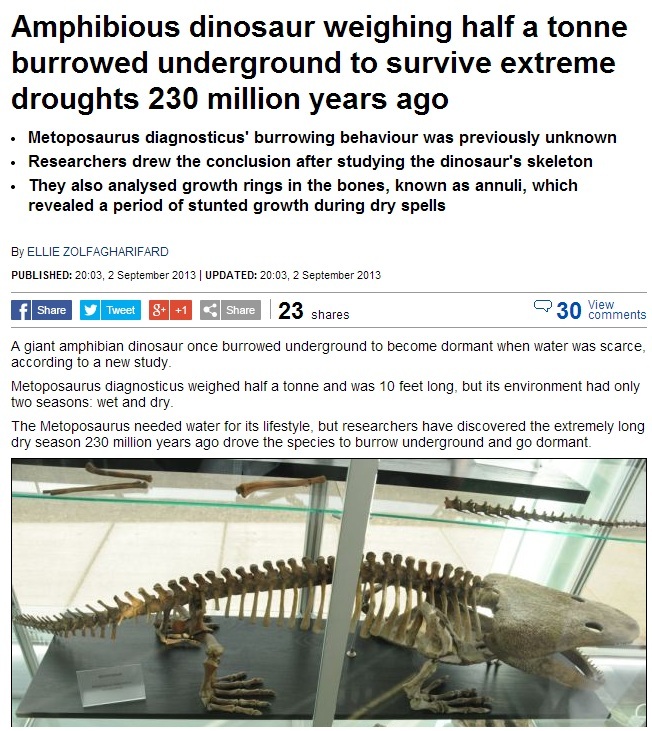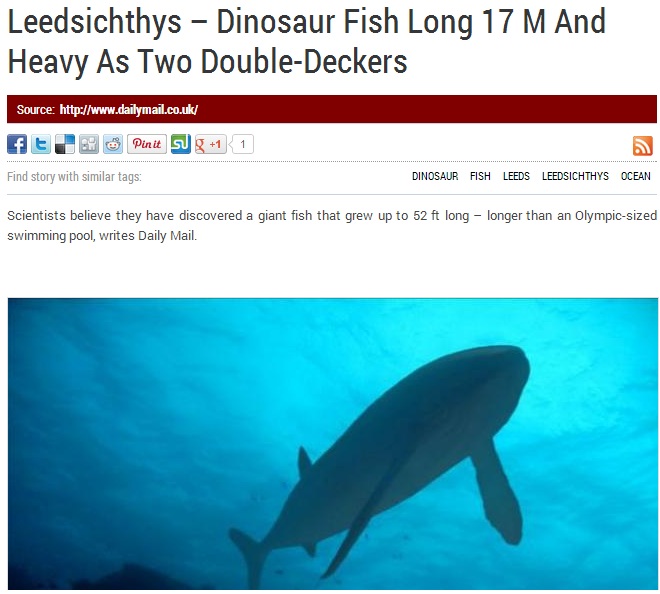The Daily Fail have struck again, this time the poor victim being the rather cool fossil, Metoposaurus diagnosticus. Metoposaurus is an amphibious, er, amphibian from Germany, Italy, Poland and Portugal, and a member of a group called temnospondyls. However, three times in an article published yesterday, the innocent amphibian is labeled as a ‘dinosaur’ – what did it ever to to deserve such dishonour!

Screenshot from the article (source)
Responses on a Facebook group for palaeo-related awesomeness were appropriately snarky, as any child who has ever read a book on fossils, or attended a biology lesson will know that an amphibian is not a dinosaur. There may have been some confusion over the use of the term ‘saurus’, meaning ‘lizard’, but not everything with the name ‘somethingsaurus’ has to be a dinoasaur; for example, Basilosaurus is a cetacean, or whale!
This actually happens quite a bit, with reporters seeming to tag ‘dinosaur’ on to anything that resembles a tetrapod (anything with 4 limbs), including sometimes even…fish (not a tetrapod)!

Ah yes, one of them 17m long fishosaurs.. (source)
So, being British, I wrote the Editor of Mail Online a letter (email) requesting that it be changed, as they wouldn’t want to develop a reputation of science miscommunication. The response:
Dear Mr Tennant
Thank you for your email.
We are investigating the points you raise and will revert back in due course.
I don’t have a clue what this means, as I wasn’t asking them to revert anything back, just to change a schoolboy error. Hopefully, they’ll follow up with appropriate changes. I also did slightly admonish them for not fact-checking, as this is a rather fundamental error to have made, and suggested that they consult a palaeontologist in future before publishing palaeo-related articles.
I’m not sure whether this is because I haven’t had any coffee yet this morning, but it is adding to my scepticism that some (many?) non-science-trained reporters simply lack the fundamental background to sufficiently cover scientific findings, or at least get the core facts correct. There are many other examples out there, of exploding ichthyosaurs, 12ft long tyrannosaur pensises, and dinosaurs farting themselves to death, that it seems, perhaps, maybe, that a lot of the time, the real science is dismissed in favour of a catchy headline or twist, and the people who lose out are everyone. Would love to hear additional thoughts on the matter.
.@Protohedgehog They missed out the key Daily Fail question – do fossils cause cancer?
— Freya Harrison (@friendlymicrobe) September 3, 2013
UPDATE: They have now changed the article: http://www.dailymail.co.uk/sciencetech/article-2408926/Prehistoric-amphibian-weighing-half-tonne-burrowed-underground-survive-extreme-droughts-230-million-years-ago.html #happyscientist 🙂

Lorna Steel
This morning’s Metro also had the same mistake. I’ve come to expect it.
Kyle Freeman
I will point out that the Metoposaurus in the picture is actually from Poland rather than Germany and most of the fossils of it are also from Poland
Matt Smith
Congratulations on effecting change! I’d also like to point out that Olympic-sized pools are 50 metres long, which is quite a lot longer than 52 feet!
Emily Devenport
When the editor told you they would “revert back in due course,” maybe he meant that the writer had the right info (or mostly right) in the headline and the editor changed it. I’m imagining the writer saying, “But an amphibian is not a dinosaur,” and the editor saying something like, “If it’s that big, it has to be a dinosaur,” or “It sure looks like a dinosaur to me,” or even, “Nobody cares about amphibians, people won’t notice this article unless we sprinkle the word ‘dinosaur’ liberally throughout the text.” Of course, they could have done that by having a title like, This Big, Fat Amphibian Isn’t A Dinosaur. But no one ever listens to me.
Pingback: This Week in Science: August 31-September 6 2013 | Scientia and Veritas